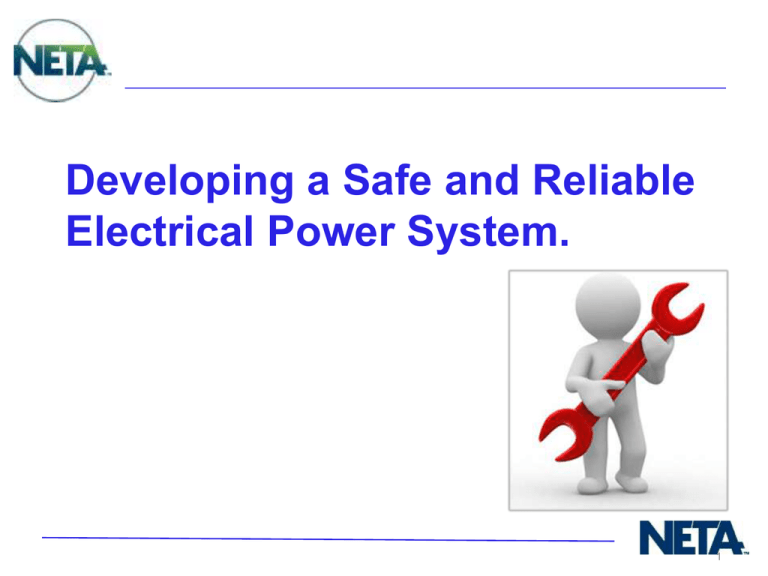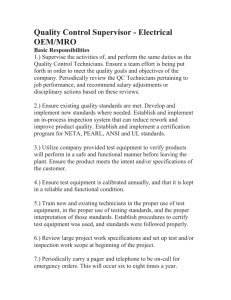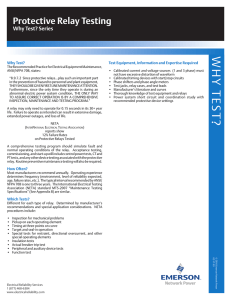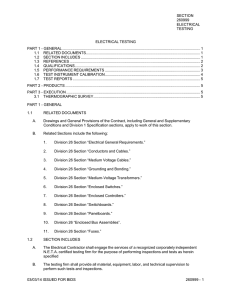Developing a Safe and Reliable Electrical Power System.
advertisement

Developing a Safe and Reliable Electrical Power System. 1 Topics for Today • • • • Who is NETA? What are the ANSI/NETA Standards? Specifying a NETA Accredited Company How can builders, contractors, architects and engineers ensure safety and reliability in electrical power system installations? • What should an electrical preventive maintenance program look like? What is NETA? NETA is an association of electrical testing companies that is committed to advancing the industry’s standards for power system installation and maintenance to ensure the highest level of electrical reliability and safety. The InterNational Testing Association • Member Companies US, Canada, Puerto Rico, Chile and Brussels • Approximately 1,500 Certified Technicians • Approximately 1,100 individual Affiliates • International Associate subscriptions include representatives from over 60 countries including Columbia, India, Thailand, Hong Kong, Finland, Saudi Arabia, Sweden, Greece, England, Australia, Cuba, Mexico and many more NETA Mission The mission of the International Electrical Testing Association is to serve the electrical testing industry by: • Establishing standards • Publishing specifications • Accrediting independent, third-party, electrical testing companies • Certifying test technicians NETA Mission The Association also: • Collects and disseminates information and data of value to the electrical industry • Educates the public and end user about the merits of electrical acceptance and maintenance testing InterNational Electrical Testing Association NETA has been an Accredited Standards Developer for the American National Standards Institute (ANSI) since 1996. ANSI recognizes NETA’s industry leadership through: • ANSI/NETA ETT-2010 • ANSI/NETA ATS-2009 • ANSI/NETA MTS-2011 InterNational Electrical Testing Association • Accreditation of third-party, independent electrical testing companies • Certification of electrical testing technicians • 40 YEARS of on going support and education of NETA members, their technicians, and friends of NETA NETA Education Tools • • • • • • NETA World Journal NETA Handbooks – 14 Volumes SPTS – Self Paced Technical Seminars Online Courses PowerTest Conference NETA Affiliate Program What are ANSI/NETA Standards? ANSI/NETA Standards The ANSI/NETA Standards address: • Standards for Acceptance Testing • Standards for Maintenance Testing • Standards for Certification of Electrical Testing Technicians ANSI/NETA Standards The Scope of the ANSI/NETA Standards is different from that of the IEEE, NECA, NEMA, and UL. – In matters of testing electrical equipment and systems NETA Standards are more comprehensive. They reference other standards developers’ documents where applicable. – NETA's review and updating of presently published standards takes into account both national and international standards. ANSI/NETA Standards The Scope of the ANSI/NETA Standards is different from that of the IEEE, NECA, NEMA, and UL. (cont.) – NETA’s standards may be used internationally as well as in the United States. – NETA firmly endorses a global standardization. – IEC standards as well as American consensus standards are taken into consideration by NETA's section panels and reviewing committees. ANSI/NETA ATS-2009 ANSI/NETA Standard for Acceptance Testing Specifications for Electrical Power Equipment and Systems Developed for assessing the suitability for initial energization of electrical power equipment and systems. Specifies field tests and inspections that ensure these systems and apparatus perform satisfactorily, minimizing downtime and maximizing life expectancy. Should always be referenced in design specifications or when performing acceptance testing on power system installations. ANSI/NETA MTS-2011 ANSI/NETA Standard for Maintenance Testing Specifications for Electrical Power Equipment and Systems - New Edition Developed for use by those responsible for the continued operation of existing electrical systems and equipment. Provides a guide in specifying and performing the necessary tests to ensure that these systems and apparatus perform satisfactorily, thus minimizing downtime and maximizing life expectancy. Should always be referenced when writing maintenance specifications or performing routine testing on electrical power systems. ANSI/NETA ETT-2010 ANSI/NETA Standard for Certification of Electrical Testing Technicians Developed to provide a standard for certification of electrical testing technicians. Created to codify the experience, education, and training requirements necessary for an individual to obtain a level of competency as an electrical test technician. Why Specify a NETA Accredited Company ? (NAC) NETA Accredited Companies NETA’s accreditation process carefully examines the qualifications of each NETA Accredited Company (NAC) in addition to certifying the individual technician employed by that NAC. Accredited Company + Certified Technician = Quality NETA Accredited Companies NETA – NAC’s Unique Qualifications 1. NETA CERTIFIED TECHNICIAN – Field Experience, Training, and Continuing Education 2. SAFETY – Setting the Standard 3. THIRD-PARTY, INDEPENDENT TESTING 4. QUALITY ASSURANCE 5. TOTAL SYSTEM EXPERIENCE – Total System Service NETA Certified Technicians • Trained on NETA Testing Standards • Technical Knowledge + Field Experience • Broad-based • Continuing Education Requirements • Backed by NETA Accredited Company • Meets ANSI/NETA ETT Safety Assurance • Industry leaders in safe work practices • Trained in complex safety assessment • Compliant with NETA and All Industry Related Safety Requirements NAC Testing Third-Party + Independent = Unbiased Evaluation Quality Assurance • NAC Corporate Infrastructure • Calibration Program • Report Parameters • PE Reviewed Reports • Continued Education and Training • Leading Technology Total System Experience All voltages, all manufacturers: • Transformers • Switchgear and CBs • Power Cable • Relaying Protection From incoming service to the mechanical load Why Test Why Test Do you believe an electrical system: • Must be designed and engineered properly. • Quality equipment should be procured. • It should be installed to all applicable codes and standards by qualified installing contractors and vendors. • Verification of all above should be performed through an independent, third – party inspection process. 27 Why Test But often projects fall victim to the following: • Poorly written specifications & contracts • Lack of understanding with respect to design and application of electrical equipment • Budget & time constraints • Unqualified contractors & installers • Use of unaccredited testing & commissioning contractors 28 Why Test Verify electrical & mechanical integrity as well as the functional performance of the electrical system Electrical acceptance testing helps determine: • If the newly-installed equipment is safe to operate • Components and installation are in conformance with drawings and specifications • Provides base-line testing results • That the equipment will function properly on all taps and settings 29 Why Test Third party testing offered by an unbiased and qualified entity provides an overall assessment of the system, based and national consensus standards and technical certifications. 30 Technician Qualifications Total System Experience NETA recognizes four levels of competency in the electrical testing industry 32 Qualifications Level I – Trainee Technician • Entry level to two years. • Typical activities include: –Simple assistance. –Simple measurements –Test equipment set up and put away –Cleaning 33 Qualifications Level II – Assistant Technician • Two years minimum experience, education. • Must pass qualifying examination. • Typical activities include: – Assists – Inspects – Tests – Data collection – Test for de-energized locked out/tagged out equipment 34 Qualifications Level III – Certified Technician • Five years’ minimum experience, education. • Must pass qualifying examination. • Typical activities include: – Lockout/tagout, safety grounding – Test for de-energized medium-voltage equipment – Performs moderately complex tasks – Interacts with other skills and operations 35 Qualifications Level IV – Certified Senior Technician • Ten years’ minimum experience, education. • Pass qualifying examination. • Typical activities include: – Test for de-energized high-voltage equipment. – Corrects system failures. – Performs very complex tests. – Interacts with engineers and managers. 36 How Can You Help Ensure Safety and Reliability? Ensure Safety and Reliability Bid Specifications Should Include: Acceptance testing of all electrical equipment and systems Testing in accordance with the most recent ANSI/NETA ATS standard Testing Performed by a NETA Accredited Company (NAC) and NETA Certified Technicians A list of local NACs MASTERSPEC NETA Standards Reference ANSI/NETA Standards Reference: Division 01 – General Requirements Division 11 – Equipment Division 21 – Fire Suppression Division 26 – Electrical Division 28 – Electronic Safety and Security Division 33 – Utilities MASTERSPEC - PART 1 GENERAL MASTERSPEC – Part 1 Current Reference DOES: Provide a general reference to testing agency and testing technician qualifications. DOES NOT: Specify compliance with the ANSI/NETA ATS Standard. Part 1 Prequalification Statement 1.5 QUALITY ASSURANCE A. Electrical Power Equipment and Systems: Tested as specified by the ANSI/NETA Standard for Acceptance Testing Specifications for Electrical Power Equipment and Systems and defined in Sections 3 – 11, by a NETA Accredited Company or equivalent third-party, independent testing agency which can function as an unbiased testing authority, professionally independent of the manufacturers, suppliers, and installers of equipment or systems being evaluated. Test technicians shall be certified in accordance with ANSI/NETA ETT-2010 Standard for Certification of Electrical Testing Technicians. Each on-site crew leader shall hold a current certification, Level III or higher, in electrical testing. B. Qualification of Testing Organization: In accordance with Section 3.1 of the ANSI/NETA Standard for Acceptance Testing Specifications for Electrical Power Equipment and Systems 1. The testing organization shall be an independent, third party entity which can function as an unbiased testing authority, professionally independent of the manufacturers, suppliers, and installers of equipment or systems being evaluated. 2. The testing organization shall be regularly engaged in the testing of electrical equipment devices, installations, and systems. 3. The testing organization shall use technicians who are regularly employed for testing services. 4. An organization having a designation of “NETA Accredited Company” issued by the InterNational Electrical Testing Association meets the above criteria. 5. The testing organization shall submit appropriate documentation to demonstrate that it satisfactorily complies with these requirements. C. The testing organization in accordance with Section 4.2 of the ANSI/NETA Standard for Acceptance Testing Specifications for Electrical Power Equipment and Systems shall provide the following: 1.All field technical services, tooling, equipment, instrumentation, and technical supervision to perform such tests and inspections. 2.Specific power requirements for test equipment. 3.Notification to the owner’s representative prior to commencement of any testing. 4.A timely notification of any system, material, or workmanship that is found deficient based on the results of the acceptance tests. 5.A written record of all tests and a final report. D. Safety and Precautions practices shall be in accordance with Section 5.1 of the ANSI/NETA Standard for Acceptance Testing Specifications for Electrical Power Equipment and Systems Specify Acceptance Testing 1.5 QUALITY ASSURANCE A. Electrical Power Equipment and Systems: Tested as specified by the ANSI/NETA Standard for Acceptance Testing Specifications for Electrical Power Equipment and Systems and defined in Sections 3 – 11 Specify Testing by a NAC A. … by a NETA Accredited Company, or an equivalent, third-party, independent testing agency which can function as an unbiased testing authority, professionally independent of the manufacturers, suppliers and installers of equipment or systems being evaluated. Specify Testing Agency Qualifications B. Qualification of Testing Organization: In accordance with Section 3.1 of the ANSI/NETA Standard for Acceptance Testing Specifications for Electrical Power Equipment and Systems 1. The testing organization shall be an independent, third party entity which can function as an unbiased testing authority, professionally independent of the manufacturers, suppliers, and installers of equipment or systems being evaluated. 2. The testing organization shall be regularly engaged in the testing of electrical equipment devices, installations, and systems. 3. The testing organization shall use technicians who are regularly employed for testing services. 4. An organization having a designation of “NETA Accredited Company” issued by the InterNational Electrical Testing Association meets the above criteria. 5. The testing organization shall submit appropriate documentation to demonstrate that it satisfactorily complies with these requirements. Specify NETA Certified Technicians • Test technicians shall be certified in accordance with ANSI/NETA ETT-2010 Standard for Certification of Electrical Testing Technicians. • Each on-site crew leader shall hold a current certification, Level III or higher, in electrical testing. Specify Technician Qualifications C. The testing organization in accordance with Section 4.2 of the ANSI/NETA Standard for Acceptance Testing Specifications for Electrical Power Equipment and Systems shall provide the following: 1. All field technical services, tooling, equipment, instrumentation, and technical supervision to perform such tests and inspections. 2. Specific power requirements for test equipment. 3. Notification to the owner’s representative prior to commencement of any testing. 4. A timely notification of any system, material, or workmanship that is found deficient based on the results of the acceptance tests. 5. A written record of all tests and a final report. Specify Testing Requirements 1.5 QUALITY ASSURANCE C. The testing organization shall provide the following: • • • • • All field technical services, tooling, equipment, instrumentation, and technical supervision to perform such tests and inspections. Specific power requirements for test equipment. Notification to the owner’s representative prior to commencement of any testing. A timely notification of any system, material, or workmanship that is found deficient based on the results of the acceptance tests. A written record of all tests and a final report. MASTERSPEC - PART 1 GENERAL ANSI/NETA Prequalification STMT MASTERSPEC – PART 3 Test Specifications ANSI/NETA ATS 2009 MASTERSPEC – PART 3 Provide Recognized Testing Agencies NETA Accredited Company List World Class Maintenance Why Perform Electrical Preventive Maintenance? “A study by The Factory Mutual Insurance Group Shows that an average of 56% of all electrical fire losses were due to lack of preventive maintenance.” Top Causes of Electrical Distribution System Failures Top Causes of Electrical Distribution System Failures 8.1% 2.2% 2.4% Loose Connections/Parts 3.9% 30.3% Moisture Line Disturbance (Other than Lightning) 7.3% Defective/Inadequate Insulation Lightning Foreign Objects/Short Circuiting 8.1% Collision Overloading/Inadequate Capacity 9.9% 17.4% 10.4% Accumulation of Dust, Dirt, and Oil All Other Causes Based on Hartford Steam Boiler Claims Data Total Failures due to Insulation Breakdown Component Transformers Circuit Breakers Disconnect Switches Insulated Switchgear Bus Bus duct Cable Cable Joints (splices) Cable Terminations Based on IEEE Gold Book Table 36 Percentage of insulation failure 84% 21% 15% 95% 90% 89% 91% 87% Electrical Preventive Maintenance Program Condition-Based Maintenance • Maintenance Planning • Predictive Maintenance • Preventive Maintenance • Proactive Maintenance • Performance Measurement and Tracking • Continuous Improvement 56 Maintenance Planning Maintenance Planning • Work Order System • Written Procedures • Planning: — Scope of Work — Budget Estimates — Resource Schedule 57 Predictive Maintenance Predictive Maintenance (PdM) • Non-invasive. • Performed while plant is operating. • Application of PdM tools and techniques. • Identify (or predict) potential failure modes. (NFPA 70B & NETA MTS) 58 Preventive Maintenance Preventive Maintenance (PM) • Can be invasive. • Performed while plant is shutdown. • Application of PM tools and techniques: — — — — Inspect Clean Lubricate Periodic and appropriate electrical testing (NFPA 70B & NETA MTS) 59 Pro-active Maintenance Pro-active Maintenance (PAM) • Reduce maintenance costs • Improve effective reliability • Improve useful life • Review operating history. — Uptime vs. downtime — Written failure analysis. • Review maintenance history. — Trending test data — Maintenance cost control 60 Performance Measurement and Tracking Performance Measurement and Tracking • Maintenance activities evaluated — — — — Reliability Accountability Reporting Trending • Established process — Tracking progress — Implementing corrective action 61 Continuous Improvement Continuous Improvement • Integrates EPM criteria results • Unified focus of plant organizations —Improved productivity —Improved performance —Improved reliability • Employee training. • Qualified contractors 62 Testing Frequency Matrix 63 Testing Frequency Matrix PdM testing is typically performed at least annually 64 Testing Frequency Matrix Predictive Maintenance N1. Physical Inspections. N2. Oil Sample Analysis. N3. Infrared Inspection. N4. Ultrasonic Emission (UE) Surveys. N5. Partial Discharge (PD) Testing. N6. Battery Tests. Nxx Denotes Description Notes in an EPM Program 65 Testing Frequency Matrix 1-2 years for HV & LV Breakers & HV Starters Most PM testing is performed on a 3-5 year cycle Exceptions: 1.) Every 1-2 years for Batteries 2.) Every 1 year for Generators 66 Testing Frequency Matrix Preventive Maintenance N7. Dielectric Overpotential (HiPot). N8. VLF Tan Delta N9. Insulation Resistance. N10. Contact/Connection Resistance. N11. Fuse Resistance. N12. Dielectric Absorption Ratio/Polarization Index N13. Power Factor/Dissipation Factor N14. Winding Resistance. N15. Turns Ratio Test N16. Vacuum Bottle Integrity. N17. Electrical Operability Test Nxx Denotes Description Notes N18. Mechanical Operability Test. in an EPM Program N19. Capacitance Test. N20. Ground Resistance. N21. Continuity Test. N22. Emergency System Operability/Load Test 67 Testing Frequency Matrix Axx Denotes Procedures from the EPM Program NFPA 70B & NETA MTS 68 Testing Frequency Matrix 69 EPM Program Discussion • Applications • Testing Requirements 70





